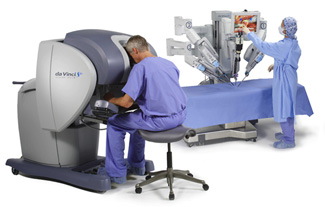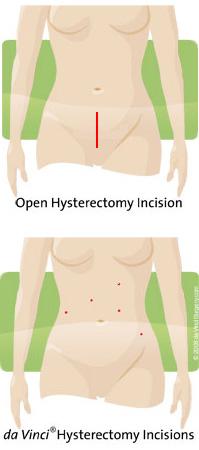The da Vinci Surgical System is a tool that helps surgeons perform a variety of surgeries including gynecological surgeries, urological, head and neck, thoracic, colorectal, cardiac and general surgeries. Because the da Vinci only uses small cuts, it’s less traumatic on your body, resulting in less pain, fewer complications and a shorter recovery time.
A da Vinci surgery is when your surgery is performed using the da Vinci Surgical System, a machine that uses four thin robotic arms. The robotic instruments have a wider range of motion than the human hand. Surgeons can use the surgical system for a variety of procedures.
The machine is made up of three different parts:

Cleveland Clinic is a non-profit academic medical center. Advertising on our site helps support our mission. We do not endorse non-Cleveland Clinic products or services. Policy
Use of the system makes your surgery “minimally invasive” (smaller incisions). The procedure uses small cuts (less than or equal to 1 centimeter long), tiny surgical instruments, fewer stitches and a laparoscope (a telescope) which is a thin tube with a light and a camera lens. This is different than traditional surgeries that use larger, more invasive cuts through skin, tissues and muscles.
The da Vinci Surgical System is designed to do several types of surgeries. However, not every type is available in every country, or at every hospital. Talk to your healthcare providers about whether or not your surgeon will use this machine. Possible surgeries include:
Cardiac (heart) surgeries:
Colorectal surgeries:
General surgeries (abdomen and digestive tract):
Gynecology surgeries:
Head and neck surgeries.
Thoracic (chest) surgeries.
Urology surgeries:
Worldwide, there have been over seven million surgeries performed using the da Vinci system.
No. The da Vinci surgical system is available only in certain countries. Ask your healthcare provider if the surgeons they work with use one.
For a hysterectomy, which is a procedure that removes the uterus, the surgeon makes four or five small cuts instead of one long incision. The robotic surgical instruments are inserted into the holes and, sitting at the console, the surgeon uses the controls to remove the organ.

Surgeons who use the da Vinci Surgical System go through additional training to learn how to use the machine.
You prepare for a da Vinci surgery the same way you prepare for an open surgery. Specific preparations depend on the type of surgery you’re getting, so you should ask your healthcare providers about the details.
This depends on the procedure. On average, da Vinci surgeries tend to last an hour more than an open surgery.
Yes. You will be under general anesthesia.
The da Vinci System enables surgeons to perform even the most complex and delicate procedures through very small, precise incisions. Benefits may include:
During the procedure:
After the procedure:
Women who were previously not candidates for laparoscopic myomectomy to remove uterine fibroids now have an option that can preserve their uterus and potentially their fertility.
There are always risks with surgery, including reactions to anesthesia and bleeding. There are two disadvantages of the da Vinci surgery:
Although they take longer and may cost more, da Vinci surgeries are just as effective as open surgeries.
How long you’ll be in the hospital depends on the type of surgery you have and your healthcare providers’ recommendations. Studies have shown that if you have a da Vinci surgery, you’re likely to have a shorter hospital stay and may go home on the same day.
Again, this depends on the type of surgery. Talk to your healthcare providers about how long your particular healing process might take.
Be sure to attend all follow-up appointments with your healthcare provider. You should also see a healthcare provider if you experience any of the following:
Don’t hesitate to call 911 or go to the emergency department if you have suspicious symptoms. Remember, no matter what procedure you had, you should always see a healthcare provider right away if you experience:
A note from Cleveland Clinic
Not every surgeon uses the da Vinci Surgical System. It’s not available at every hospital or for every type of surgery. However, da Vinci surgeries are becoming more and more popular as more healthcare providers learn about it. Speak with your own healthcare providers about the possibility of replacing an open surgery with a da Vinci surgery.
Last reviewed by a Cleveland Clinic medical professional on 05/24/2021.
Learn more about our editorial process.
Cleveland Clinic is a non-profit academic medical center. Advertising on our site helps support our mission. We do not endorse non-Cleveland Clinic products or services. Policy